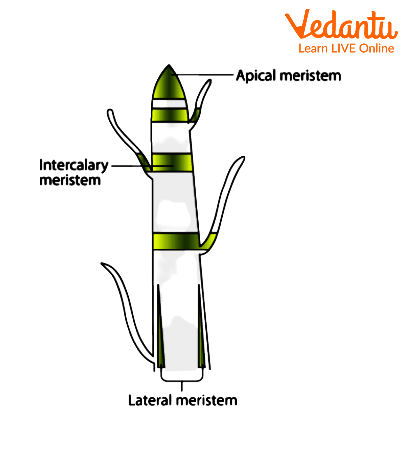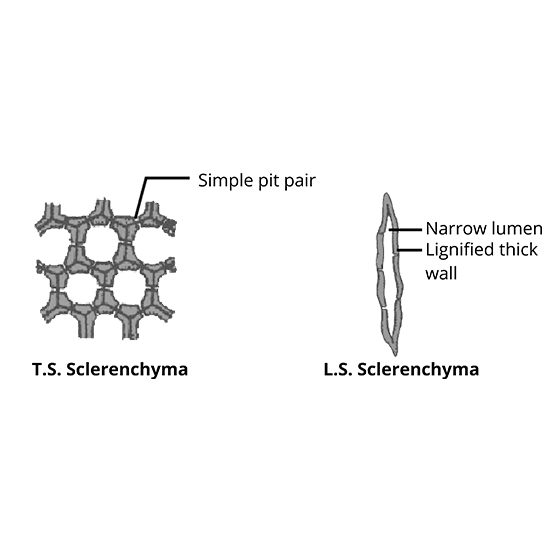What Are the Different Types of Plant Tissues and Their Functions?
Plant tissues form the basis of all plant structure and function, making them essential for growth, support, and transport. Understanding plant tissues helps students explore how plants adapt, heal, and thrive in different environments. This knowledge is vital for studies in plant biology, agriculture, and the environmental sciences. In this article, we will explore the types, characteristics, and importance of plant tissues in detail.
Plant Tissues Definition
Plant tissues are groups of cells in plants that work together to perform specific functions. Each tissue type is specialized for a unique role like support, transport, protection, or storage. Knowing the plant tissues definition is key to understanding the organization of the plant body from roots to leaves.
Classification and Types of Plant Tissues
Plant tissues can be broadly classified into two main categories: meristematic tissues and permanent tissues. This classification depends on the ability of cells to divide and their functional roles in the plant body. Let’s look deeper into their types and features.

1. Meristematic Tissues
These tissues contain actively dividing cells. Meristematic tissues are responsible for plant growth and are mainly found in regions such as shoot tips, root tips, and cambium.
- Apical Meristem – Found at the tips of roots and shoots, causing lengthwise growth.
- Lateral Meristem – Located along the sides of stems and roots, leading to the thickening of these organs.
- Intercalary Meristem – Located at internodes or base of leaves, important for growth in grasses.
2. Permanent Tissues
After cells of the meristematic tissue stop dividing, they become permanent tissues. These cells mature to perform specific roles in the plant body. Permanent tissues can be simple or complex.
- Simple Permanent Tissues:
- Parenchyma – Soft, thin-walled living cells; functions include storage, photosynthesis, and tissue repair.
- Collenchyma – Elongated living cells with thickened corners; provides flexibility and mechanical support.
- Sclerenchyma – Hard, thick-walled cells; often dead at maturity, giving plants rigidity and strength.
- Complex Permanent Tissues:
- Xylem – Transports water and minerals from roots to other plant parts; composed of tracheids, vessel elements, xylem fibres, and parenchyma.
- Phloem – Moves organic nutrients (like sugars) throughout the plant; consists of sieve tubes, companion cells, phloem parenchyma, and fibres.
Structure and Functions of Major Plant Tissues
Each plant tissue displays special structures to carry out its function efficiently. Here are the details:
Simple Permanent Tissues
- Parenchyma: Loosely packed, isodiametric cells. Store water, starch, and help in photosynthesis (in leaves as chlorenchyma).
- Collenchyma: Irregularly thickened cell walls at corners. Provides flexibility for bending of stems and leaves.
- Sclerenchyma: Thick, lignified walls. Offers structural support, often found in stems, seeds, and fibres (like jute).

Complex Permanent Tissues
- Xylem: Made of vessel elements and tracheids (dead), xylem fibres, and living parenchyma. Moves water and dissolved minerals upward, supports the plant.
- Phloem: Contains sieve tube elements, companion cells (living), parenchyma, and fibres. Distributes sugars produced in photosynthesis to all parts.
Dermal Tissue System
The dermal tissue is the plant’s outermost layer, acting like skin. It consists primarily of the epidermis, which protects against water loss and pathogens. Specialized extensions like trichomes, root hairs, and guard cells aid defense and gas exchange. In woody plants, the periderm replaces the epidermis and forms bark.
Types of Plant Tissues (Summary Table)
| Type | Main Features | Key Functions |
|---|---|---|
| Meristematic | Dividing, small thin-walled cells | Growth, formation of new cells |
| Parenchyma | Living, thin-walled, large vacuoles | Storage, photosynthesis, healing |
| Collenchyma | Living, unevenly thickened corners | Flexibility, mechanical support |
| Sclerenchyma | Dead, thick lignified walls | Rigidity, strength |
| Xylem | Vessels, tracheids, fibres | Transport water/minerals |
| Phloem | Sieve tubes, companion cells | Transport food |
| Dermal (Epidermis) | Outer covering, may secrete cuticle | Protection, water conservation |
This table offers a concise plant tissues summary for quick reference and revision.
Plant Tissues Examples and Their Importance
Looking at plant tissues examples reveals how each type supports plant survival in different ways:
- Parenchyma in potato tubers – stores starch as food reserve.
- Collenchyma in celery stalks – gives flexibility and crunch.
- Sclerenchyma fibres in coconut husk – offers strength for protection.
- Xylem vessels in stems – quickly transport water for photosynthesis.
- Phloem in leaves – carries sugars to storage organs like fruits and roots.
In food science and agriculture fields, understanding these tissues simplifies processes like food processing, crop breeding, and plant-based product manufacturing.
Plant Tissues Diagram & Visualization
Plant tissues diagrams are vital for visualizing cellular arrangement in roots, stems, and leaves. Diagrams typically show epidermis, cortex, vascular bundles (xylem and phloem), and pith. Diagrams also aid in understanding differences between dicot and monocot plant tissues, which appear in many biology textbooks and exams.
Plant Tissues – Role in Plant Growth and Adaptation
Plant tissues help plants grow, heal after injury, store food, and transport essential substances. For example, meristematic tissues can regenerate lost leaves or roots, while dermal tissues form a protective barrier against pathogens and water loss. Vascular tissues are crucial for tall trees, enabling efficient transport of water and nutrients from roots up to the highest branches.
Understanding these roles connects well with larger concepts like inheritance and adaptation, effects of climate changes, and the significance of biomolecules in plant life.
Plant Tissues Notes: Key Points for Revision
- Plant tissues are groups of cells with specialized functions.
- Classified as meristematic (growth) or permanent (mature functional cells).
- Simple tissues: parenchyma (storage), collenchyma (support), sclerenchyma (rigidity).
- Complex tissues: xylem (water), phloem (food).
- Dermal tissues (epidermis) protect and conserve water.
- Structure and function depend on location within the plant.
These plant tissues short notes can be used for school revision or study materials like plant tissues ppt or plant tissues class 12 exam prep.
Application and Relevance of Plant Tissues
Plant tissues are not only a key topic in biology but also have real-life applications in medicine, environmental conservation, and agriculture. For instance, sclerenchyma fibres are used as natural fibres for ropes or textiles, while xylem wood supports construction and furniture industries. In biotechnology, plant tissues are used for tissue culture and genetic modification, helping create drought-resistant or high-yield crops. Environmental science uses plant tissue analysis to monitor pollution and ecosystem health. At Vedantu, students can explore these interdisciplinary links for holistic science learning.
Plant Tissues MCQs and Questions
To prepare for competitive exams, practice plant tissues MCQs and plant tissues questions. These often test identification, functions, and differences between tissue types. Practice questions help reinforce understanding for boards and entrance exams.
Download Plant Tissues Notes & Study Material
Students can prepare plant tissues notes or utilize structured plant tissues pdf resources for last-minute revision. Diagrams, mnemonics, and tables consolidate learning. For academic excellence, regular practice and concept mapping are encouraged.
Plant tissues are an essential topic in biology, shaping our knowledge of how plants function and adapt. Mastery of their structure and function underpins studies in botany, food science, and the environment. By learning about plant tissues, students gain insights relevant to medicine, agriculture, and climate studies, paving the way for advanced scientific exploration.


FAQs on Understanding Plant Tissues
1. What are the main types of plant tissues?
Plant tissues are categorised into two main types: meristematic tissue and permanent tissue. The classification of plant tissues is essential for understanding plant structure and function.
- Meristematic tissue: Responsible for growth; found at root and shoot tips.
- Permanent tissue: Derived from meristematic tissue; divided into simple tissues (parenchyma, collenchyma, sclerenchyma) and complex tissues (xylem, phloem).
2. What is meristematic tissue and where is it found?
Meristematic tissue is a type of plant tissue made up of actively dividing cells that enable plant growth.
- Located at shoot apex and root apex (apical meristems)
- Also found at lateral regions (lateral meristems) and between mature tissues (intercalary meristems)
- Responsible for primary and secondary growth
3. What are permanent tissues in plants?
Permanent tissues are plant tissues whose cells have lost the ability to divide and are specialised for specific functions.
- Formed from meristematic tissues after differentiation
- Divided into simple permanent tissues (parenchyma, collenchyma, sclerenchyma) and complex permanent tissues (xylem, phloem)
- Help in support, storage, and conduction of water and food
4. What are the functions of parenchyma, collenchyma, and sclerenchyma tissues?
Parenchyma, collenchyma, and sclerenchyma are simple permanent tissues with distinct functions in plants.
- Parenchyma: Storage of food and water, healing, photosynthesis (if chloroplasts are present)
- Collenchyma: Provides flexible support to growing parts like stems and leaves
- Sclerenchyma: Gives mechanical strength and rigidity; made up of dead cells
5. Describe the structure and function of xylem and phloem tissues.
Xylem and phloem are complex permanent tissues involved in transport within plants.
- Xylem: Transports water and minerals from roots to other plant parts; consists of vessels, tracheids, xylem fibres, and xylem parenchyma
- Phloem: Transports food (sugar) from leaves to other parts; made up of sieve tubes, companion cells, phloem fibres, and phloem parenchyma
6. What is the difference between meristematic and permanent tissues?
Meristematic tissues actively divide for plant growth, while permanent tissues are specialised and no longer divide. The main differences include:
- Meristematic tissue: Undifferentiated, small cells with dense cytoplasm; found in growing regions
- Permanent tissue: Differentiated, larger cells with specific functions; form the main plant body
7. Why is sclerenchyma called dead tissue?
Sclerenchyma is called a dead tissue because its cells lose their protoplasm at maturity, making them dead and rigid.
- Cells have thick, lignified walls
- Provide mechanical strength and support to plant parts
- Common in stems, seeds, and husks
8. What are the functions of epidermal tissue in plants?
Epidermal tissue forms the outer protective covering of plants. Its main functions include:
- Protection against injury, water loss, and infection
- Regulates gas exchange through stomata
- May have specialised structures like root hairs for absorption
9. What is the role of stomata in plants?
Stomata are tiny openings in the epidermal tissue of leaves responsible for gas exchange. Their key roles are:
- Facilitate exchange of oxygen, carbon dioxide, and water vapour
- Play a major role in photosynthesis and transpiration
- Regulated by guard cells
10. Differentiate between xylem and phloem tissue?
Xylem and phloem are complex tissues with distinct transport functions in plants.
- Xylem: Transports water and minerals from roots to leaves; provides mechanical support
- Phloem: Transports organic food from leaves to other plant parts; does not provide support
- Xylem has dead cells, phloem mainly has living cells










